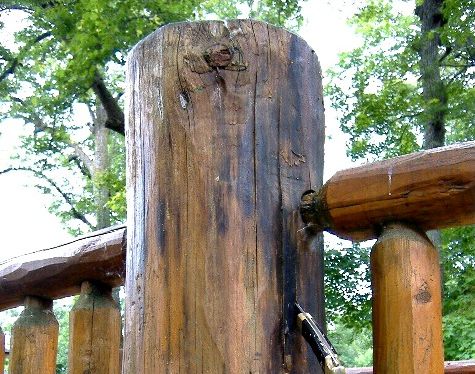
Log railings are something we get asked about from time to time. In the restoration business, we mostly hear about them when the railings are deteriorating. The main problem with log railings is that in most cases, they are out in the weather, which can lead to wood rot. Being in the rain, sun, and wind, they soak up a lot of moisture. High moisture is the key ingredient in rot and a recipe for disaster for any wood. (See Why Logs Rot )

The crux of the problem is that it is incredibly difficult to keep the moisture in log railings at an acceptable level. The tops of posts are the most vulnerable place for rot on a set of log railings because the end grain is facing up, acting like a sponge for collecting moisture.
The second vulnerable spot on log railings is the top edge of the bottom rail. There are a series of holes facing upwards where the spindles pass through. When it rains, water follows the contour of the spindle and through capillary action, it flows right into these holes and soaks into the bottom rail as well as the end grain of the spindle itself. pine railings
The third area of particular vulnerability in log rails is the post base when they travel through a deck and support the structure. Again, we have end grain in a potentially moisture-rich environment. We generally see the first signs of rot in all three of these vulnerable areas.

There are three things that can done to extend the life of log railings.
Doing all three things will add life to log rails.
The last important thing to do is to keep a good finish on the railings. The fact that they are typically out in the sun and rain makes it very important to keep good finish on the railings. Unfortunately, this is easier said than done. Railings have so many surfaces and contours that they are a real pain to stain. Nonetheless, it is important to keep a quality stain on them, which is part of the solution to maintaining and extending the life of the railings.
Log cabin maintenance you can do yourself – caulking cracks in your logs Log home maintenance issues sometimes need to…
August 4, 2011
Log Home Tips: Attaching Decks to Logs Although we are a long way from the “dog days” of summer –…
January 9, 2015
We often get calls from people who are looking at purchasing a log home for the first time. A common…
January 3, 2019